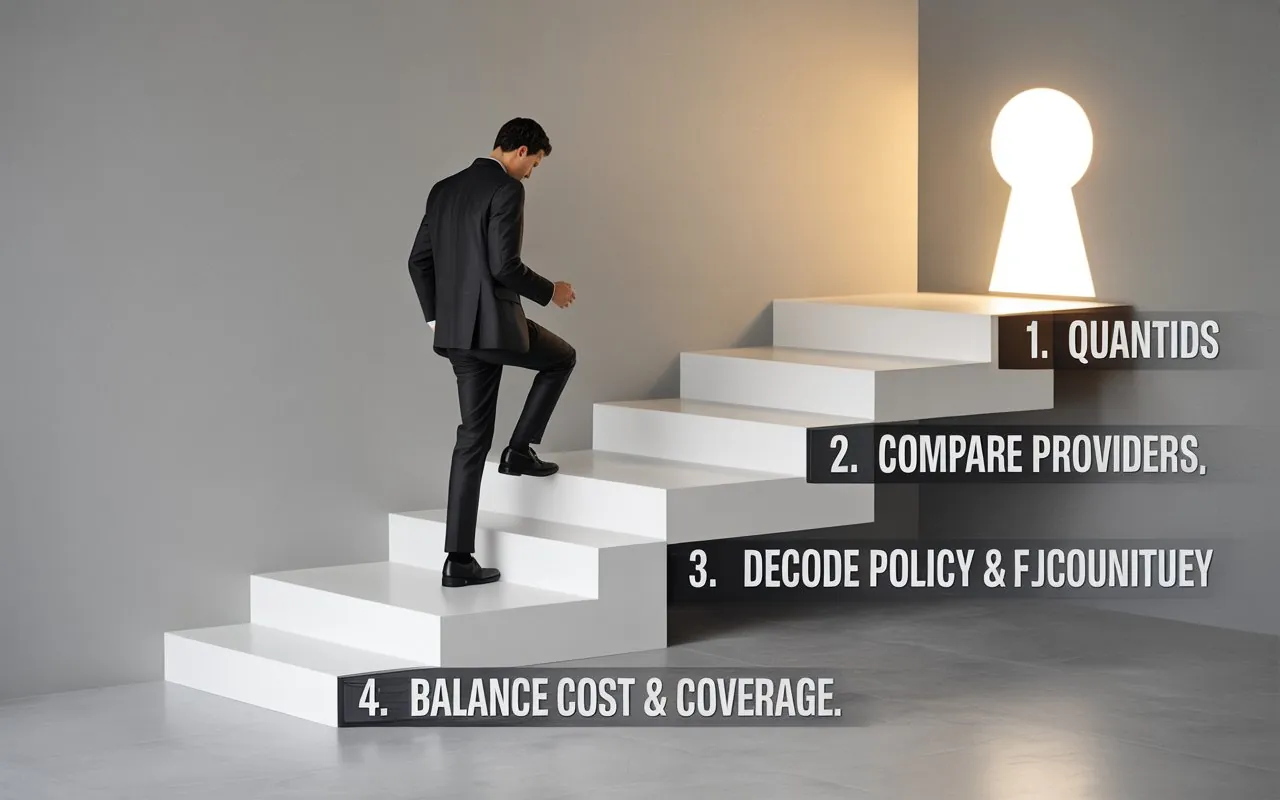Navigating the world of insurance can often feel like trying to read a map in a foreign language. With an endless sea of policies, providers, and perplexing jargon, the process can be overwhelming, leaving many people feeling uncertain and underprepared. Yet, at its core, insurance is one of the most powerful tools we have for building a life of security and peace of mind. It’s a safety net for our families, a shield for our assets, and a promise that an unexpected storm won’t capsize our financial future. This brings us to the single most important question in this entire landscape: how to choose the right insurance policy for your needs?
This comprehensive guide is designed to be your trusted compass, helping you navigate this complex terrain with clarity and confidence. We will break down the entire process into simple, actionable steps, transforming confusion into a structured plan. This is not just about buying a product; it’s about making one of the most critical financial decisions of your life. By the end of this journey, you will have a deep, practical understanding of how to choose the right insurance policy for your needs, empowering you to select the perfect coverage to protect what matters most to you.
The First Step: A Deep Dive into Your Own Life
Before you can even begin to look at policies, you must first look in the mirror. The absolute foundation of learning how to choose the right insurance policy for your needs is to conduct a thorough and honest assessment of your own life circumstances. Insurance is not a one-size-fits-all product; a policy that is perfect for your neighbor might be completely wrong for you. Your goal is to create a detailed snapshot of your life as it is today and where you see it going.

To begin this crucial self-assessment, consider the following areas:
- Your Life Stage: Are you a young, single individual just starting your career? A newly married couple planning for the future? A family with young children? Or are you an empty nester nearing retirement? Your age and life stage dramatically influence your priorities and risks.
- Your Dependents: Who relies on you financially? This includes your spouse, children, and potentially aging parents. The number of dependents you have and their needs are a primary factor in determining the type and amount of coverage you require, especially for life and health insurance.
- Your Assets: What do you own that needs protection? This includes your home, vehicles, valuable personal property like jewelry or art, and any businesses you may own. Make a comprehensive list of your significant assets.
- Your Liabilities: What debts are you responsible for? This includes your mortgage, car loans, student loans, and credit card debt. In the event of your death or disability, these debts don’t disappear; a proper insurance plan ensures they don’t become a burden on your family.
- Your Health and Lifestyle: Your current health status, family medical history, and lifestyle choices (such as whether you smoke or engage in high-risk hobbies) will impact your insurance needs and the premiums you pay.
Taking the time for this introspective step is non-negotiable. It is the only way to get a clear picture of what you are trying to protect. This self-assessment provides the “why” behind your insurance decisions and is the most important part of the answer to how to choose the right insurance policy for your needs.
Understanding the Insurance Landscape: The Main Types of Coverage
Once you have a clear picture of your life, the next step is to understand the basic tools at your disposal. Insurance policies can be broadly categorized, with each type designed to protect against a specific set of risks. Let’s break down the most essential types.

Life Insurance
Life insurance provides a tax-free, lump-sum payment (known as a death benefit) to your designated beneficiaries upon your death. Its primary purpose is to replace your lost income and ensure that your family can maintain their standard of living. There are two main categories:
- Term Life Insurance: This provides coverage for a specific period or “term” (e.g., 10, 20, or 30 years). It is generally the most affordable type of life insurance and is ideal for covering needs that have a specific timeframe, like paying off a mortgage or seeing children through college.
- Permanent Life Insurance (e.g., Whole Life): This type of policy provides coverage for your entire life and includes a cash value component that grows over time. These policies are more expensive but offer lifelong protection and can serve as a savings or investment tool.
Health Insurance
Health insurance is designed to cover the costs of medical care, from routine doctor’s visits to major surgeries and hospital stays. Without it, a single serious illness or accident could lead to devastating financial hardship.
Disability Income Insurance
This is one of the most overlooked but crucial types of insurance. Disability insurance replaces a portion of your income if you become unable to work due to an illness or injury. Your ability to earn an income is your most valuable asset, and this policy protects it.
Property and Casualty Insurance
This broad category includes insurance for your physical belongings.
- Auto Insurance: Protects you against financial loss in the event of a car accident or theft.
- Homeowners or Renters Insurance: Covers damage to your home and its contents from events like fire, theft, or natural disasters.
Understanding these basic categories is a prerequisite for figuring out how to choose the right insurance policy for your needs.
How to Choose the Right Insurance Policy for Your Needs: A Step-by-Step Method
With your self-assessment complete and a basic understanding of the types of policies available, you are now ready to begin the selection process. This methodical approach will ensure you make an informed and confident decision.

Step 1: Quantify Your Coverage Needs
It’s not enough to know you need life insurance; you need to know how much life insurance you need. For each type of insurance, you must determine the appropriate coverage amount.
- For Life Insurance: A common rule of thumb is to have coverage that is 10 to 15 times your annual income. However, a more precise method is to calculate your family’s specific financial needs. Add up your outstanding debts (mortgage, loans), future expenses (like college tuition for your children), and the amount of income your family would need to replace, and for how long.
- For Disability Insurance: Your goal should be to get a policy that replaces 60-70% of your gross income. This is typically the maximum amount insurers will offer.
- For Home Insurance: Ensure your dwelling coverage is sufficient to completely rebuild your home at current construction costs, not just its market value. Your contents coverage should be enough to replace all of your personal belongings.
This quantification step is what turns a vague need into a concrete goal. This is a practical step in learning how to choose the right insurance policy for your needs.
Step 2: Research and Compare Different Providers
Once you know how much coverage you need, it’s time to shop around. Do not simply go with the first company you see an advertisement for. The insurance market is highly competitive, and premiums for the same amount of coverage can vary significantly between providers.
When comparing companies, look beyond just the price. Consider these factors:
- Financial Stability: You need to be sure that the company you choose will be around to pay your claim, potentially decades from now. Look for ratings from independent agencies that assess the financial strength of insurance companies.
- Claim Settlement Ratio (CSR): This ratio tells you the percentage of claims the company has approved and paid out compared to the total number of claims it received in a year. A consistently high CSR (ideally above 95%) is a strong indicator of a reliable and trustworthy insurer.
- Customer Service and Reviews: Read reviews from current customers to get a sense of their experience, particularly with the claims process. Is the company responsive, helpful, and fair?
Step 3: Decode the Policy Document
This is arguably the most intimidating step, but it is absolutely essential. You must read and understand the policy documents before you sign anything. The “fine print” is where the true value of a policy is defined. Pay close attention to these key terms:
- Premium: The amount you pay for the policy, usually on a monthly or annual basis.
- Deductible: The amount of money you must pay out-of-pocket for a claim before the insurance company starts to pay. A higher deductible usually means a lower premium, and vice-versa.
- Coverage Limits: The maximum amount the insurance company will pay out for a covered claim.
- Exclusions: These are specific situations or conditions that are not covered by the policy. This is one of the most important sections to read.
- Riders: These are optional add-ons that provide extra benefits or coverage for an additional cost. For example, a critical illness rider on a life insurance policy will pay out a benefit if you are diagnosed with a major illness.
If you do not understand something in the policy document, ask for clarification. This diligence is a core part of how to choose the right insurance policy for your needs.
Step 4: Balance Cost vs. Coverage
It is tempting to simply choose the policy with the lowest premium. However, this can be a costly mistake. A cheaper policy often comes with less coverage, higher deductibles, or more exclusions. The goal is not to find the cheapest policy, but to find the best value. This means finding a policy that provides the comprehensive coverage you need at a price that is fair and affordable for your budget. The process of how to choose the right insurance policy for your needs is about optimizing for value, not just for price.
How to Choose the Right Insurance Policy for Your Needs: Final Checks and Considerations
You’ve done your research, compared your options, and are close to a decision. Here are a few final considerations to ensure you’ve covered all your bases.

Seeking Professional Advice
While this guide provides a strong framework, sometimes it helps to talk to a professional. A qualified, independent insurance agent or financial advisor can provide personalized guidance and help you navigate the complexities of different policies. They can help you identify needs you may have overlooked and can often access policies that aren’t available directly to the public. Their expertise can be invaluable in the process of how to choose the right insurance policy for your needs.
The Importance of Review and Adaptation
Choosing an insurance policy is not a “set it and forget it” decision. Your life is not static, and neither are your insurance needs. It is crucial to review your policies every few years, or whenever you experience a major life event, such as:
- Getting married or divorced
- Having a child
- Buying a new home
- Getting a significant salary increase
- Starting a business
Regularly reviewing your coverage ensures that your safety net continues to fit your life perfectly. This ongoing process is the final step in truly mastering how to choose the right insurance policy for your needs. Remember that how to choose the right insurance policy for your needs is a recurring question throughout your life. For every major life change, you must revisit the question of how to choose the right insurance policy for your needs. The ability to adapt your plan is a key skill in knowing how to choose the right insurance policy for your needs.
Frequently Asked Questions (FAQs)

Q: What is the very first step in how to choose the right insurance policy for your needs?
A: The first and most important step is to conduct a thorough self-assessment. You need to understand your life stage, dependents, assets, liabilities, and overall health to know exactly what you need to protect before you can even look at policies. This personal inventory is the bedrock of how to choose the right insurance policy for your needs.
Q: Should I just buy the cheapest policy available?
A: No, this is a common mistake. The best approach for how to choose the right insurance policy for your needs is to find the best value. Understanding this distinction is fundamental to how to choose the right insurance policy for your needs, as the cheapest option can leave you dangerously underinsured by having high deductibles or critical exclusions.
Q: How do I know how much life insurance coverage to get?
A: A popular guideline is 10-15 times your annual income. However, a more accurate method is essential. A more detailed calculation is a better strategy for how to choose the right insurance policy for your needs. This is because a key part of how to choose the right insurance policy for your needs is matching the coverage amount to your family’s specific debts (like a mortgage) and future expenses (like college tuition).
Q: Do I need to review my insurance policies after I buy them?
A: Yes, absolutely. A critical and often-forgotten part of the process is understanding that how to choose the right insurance policy for your needs is an ongoing task. Truly mastering how to choose the right insurance policy for your needs means you must review your coverage every few years or after any major life event like getting married, having a child, or buying a home to ensure your protection still fits your life.
Conclusion: The Confidence of Being Prepared

The journey to find the perfect insurance coverage begins with a single, foundational question: how to choose the right insurance policy for your needs? As we have seen, the answer lies not in a secret formula, but in a diligent, methodical process. It’s about taking the time to understand yourself, your risks, and the tools available to protect what you’ve built.
By assessing your unique situation, quantifying your coverage needs, researching your options thoroughly, and understanding the fine print, you transform from a passive buyer into an empowered decision-maker. You move from a place of uncertainty to a place of confidence, knowing that you have a robust safety net in place.
The peace of mind that comes from being well-insured is immeasurable. It is the freedom to pursue your dreams, take calculated risks, and live a fuller life, all with the quiet confidence that you and your loved ones are protected from the unexpected. Mastering how to choose the right insurance policy for your needs is not just a financial task; it is an act of profound care for yourself and your family. And that is the best return on investment you can ever hope for. Remember that how to choose the right insurance policy for your needs is a skill that will serve you for a lifetime.